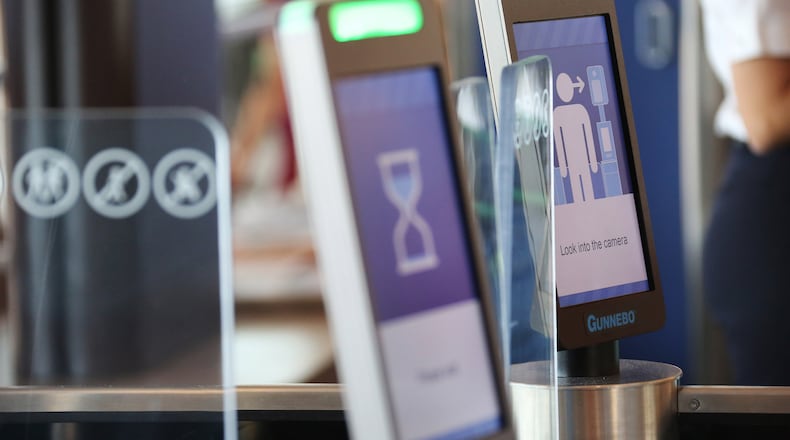ORLANDO, Fla. — More than 200 passengers queued at Orlando International Airport for a recent evening departure to London, shuffling to a pair of subway-style gates, stepping onto yellow footprints and then looking up at cameras a bit more than an arm’s length away.
After their faces came into focus on the cameras’ screens, the gate doors parted, allowing the passengers to find their seats on a waiting Boeing 777.
The passengers had shown no boarding pass, passport or any other identification.
Instead, a U.S. Customs and Border Protection computer was comparing each traveler’s passport photo on file — or a visa photo of those not from the U.S. — with their newly captured portrait.
It was as quick as a Google search for most passengers. The British Airways waiting area emptied in 15 minutes, nearly half the ordinary time.
For several months, the airport has worked with British Airways to test facial-recognition, or biometric screening. Recently, the Greater Orlando Aviation Authority moved to equip the airport as the first in the nation to use the technology for all international flights inbound and outbound.
The experience of the novel technology in an otherwise timeworn routine was remarked upon by an elderly British Airways passenger, who clutched a burgundy passport splayed at its photo page, where a boarding pass was tucked, both ready for the customary presentation.
She paused short of the yellow footprints, plainly drawing a blank.
“Now, what do I do?” she asked cheerfully with a British accent.
John Newsome, the airport’s chief information officer, said all of the airport’s 25 carriers with foreign flights and the two border checkpoints will be equipped for biometric screening through this summer.
The decision means spending $4 million on gates and high-definition cameras for departing and arriving international flights.
Orlando’s airport now ranks as the nation’s 11th and the world’s 39th busiest airport. Of more than 45 million passengers annually, about 6 million are international.
Newsome provided details about the airport’s embrace of biometric screening — including how the photographs are matched against a temporarily assembled gallery of images for each flight — but stressed two points.
“It’s a lot less hassle for the passenger,” said Newsome, who then added: “The airport has no access whatsoever to those images.”
In an era of online breaches of privacy, theft of financial information and fears of government surveillance, Orlando International and Customs and Border Protection are readily equipped with talking points about what happens with those high-definition snapshots taken for biometric screening.
At digital speed, they explained, the photographs are matched with passport or visa photos. The border agency then issues a notice to the airline and a command to the mechanical gate.
Typically, a few passengers are rejected and directed to boarding personnel, usually for minor matters such as discrepancies in ticket details or glasses obscuring the live photo, Newsome said.
But, with the program still is in its infancy, the border-protection agency has touted a number of anecdotes about snaring criminals and foreign nationals illegally in the U.S.
“Right now a lot of our criminal-justice system is based on the biographic and now we are adding in the biometric, which is quite helpful in determining who should and should not enter the country,” said Colleen Manaher, a Customs and Border Protection director overseeing biometric implementation.
Dan Tanciar, Customs and Border Protection’s deputy director for biometric screening, said the photos of foreign nationals will be kept for 75 years.
“For U.S. citizens, we take that picture and match it against a document and very soon after discard that live photo,” Tanciar said.
For now, the agency will keep the photos for 14 days as part of validating the program’s accuracy.
“At some point in the future, that time frame is going to shrink and photos of U.S. citizens probably won’t be kept at all,” Tanciar said.
According to Customs and Border Protection, photos are rendered into “strings of multiple numbers” that cannot be translated by anyone but the agency.
Tanciar said the biometric data is encrypted and linked to a unique identifier from the airline’s flight manifest.
“We’ve tried to strip out as much personally identifiable information as we can in this transaction,” Tanciar said. “There is a pretty robust security protocol around how we are doing that cloud transaction.”
Customs and Border Protection has a suggestion for passengers with concerns about biometric screening: request a manual check.
Within the past year, biometric screening also has been piloted by Delta at JFK and Atlanta International, Lufthansa at Los Angeles International, and by JetBlue in Boston.
Addressing the accuracy of its facial-recognition technology, the agency has reported that the “percent of successful matches is in the high 90s.”
Agency authorities would not comment on the accuracy rate of passenger verification performed by airline employees who manage the boarding of outbound planes and by agency officers receiving arrivals.
But the agency provided a 2016 report by the U.S. Department of Commerce’s National Institute of Standards.
It concludes that facial-screen technologies “compete favorably with humans.”
About the Author

